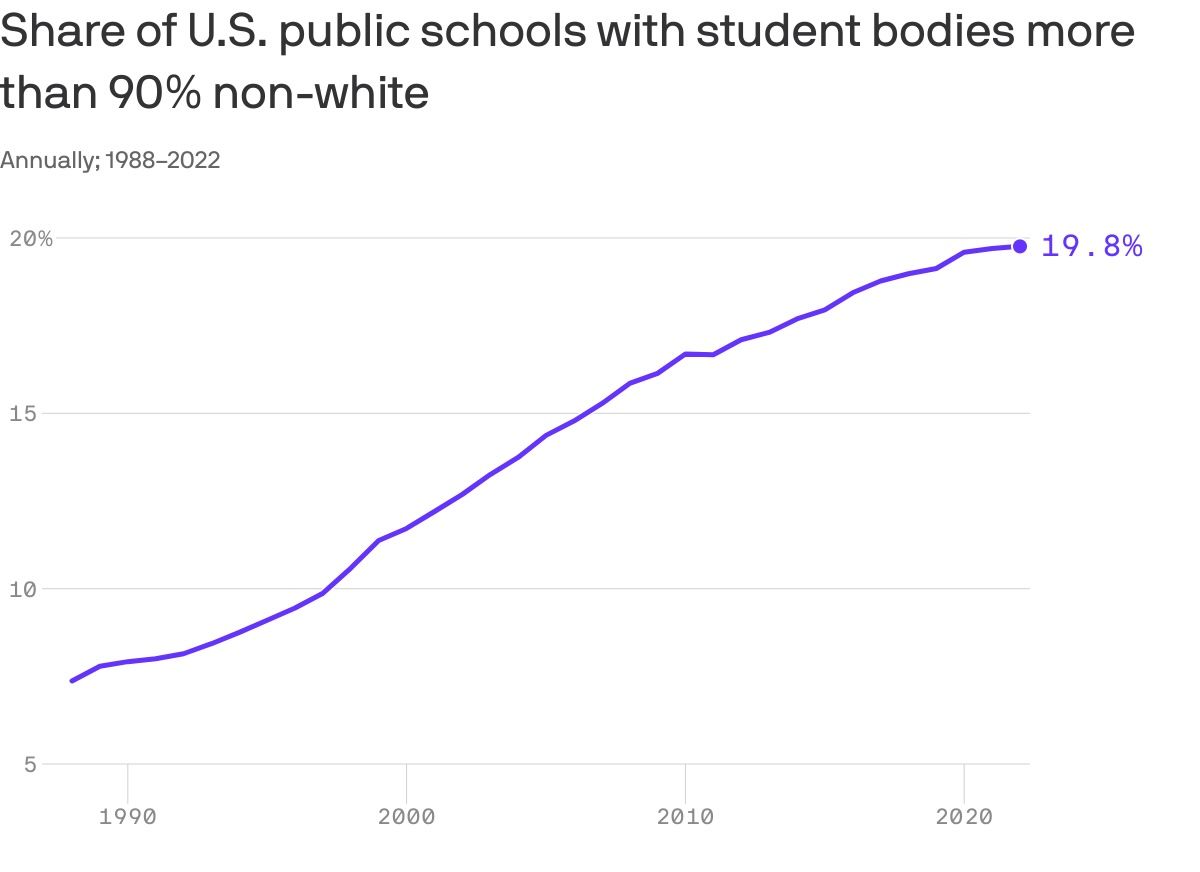Startup nonprofit Brown's Promise wants to reignite a national conversation about school desegregation, using litigation and other means to redraw district lines and bring about equitable school funding.
Why it matters: On the 70th anniversary of the Brown v. Board of Education ruling — this Friday — American schools are highly segregated and unequal.
Driving the news: Since its founding last June, Brown's Promise has been busy working to revive the school desegregation debate — and discussions about inequality in school resources.
- It has filed an amicus brief in a Maryland case seeking to integrate Baltimore city schools.
- It's planning at least one desegregation lawsuit against a state by the end of the year (but still figuring out which state to target).
- It has set up a community of practice with other groups — like the Education Law Center and the National Coalition on School Diversity — for ongoing strategy sessions.
The latest: Brown's Promise just released a document outlining the problem and potential remedies.
- It's calling for people to "hold the state responsible" to "adequately and equitably" fund public schools.
- It wants states to "rethink school district lines" and "ensure within-district integration."
Backstory: The group's two founders — Ary Amerikaner, a policy expert, and Saba Bireda, a lawyer — worked together on equity issues at the Obama-era Department of Education.
- They both saw a big need for people working on desegregation to join forces with people working on resources for underserved schools.
- "We were never talking about integration at the same time as we were talking about equitable school funding," Bireda tells Axios.
- Their organization is housed at the Southern Education Foundation.
Between the lines: Decades of post-Brown efforts to integrate schools through federal court action have come to naught, so Bireda and Amerikaner are focusing their attention on state courts.
- "We are ambitiously hoping to be able to file one to three lawsuits [against states] as our first wave," Bireda says.
- Other lawsuits seeking court-ordered integration are already underway in Minnesota and New Jersey.
- Some desegregation advocates are even calling for the return of mandatory busing, as the Wall Street Journal reports.
Brown's Promise is also trying to encourage conversations about redrawing school district lines — even across municipal boundaries, an idea that's proven controversial and difficult.
- The goal is that an urban district with a disproportionate number of students of color would be reconfigured to include surrounding areas with more white students (or vice versa).
- That could be done through magnet schools, voluntary busing or other creative remedies, such as the pooling of property taxes, Amerikaner says.
- But not through federal litigation: Milliken v. Bradley, a landmark 1974 Supreme Court ruling, determined that the Detroit suburbs couldn't be compelled to alleviate segregated conditions in the city's school system — a precedent that rules the land today.
What they're saying: "It's clear that our schools are highly segregated today and going in the wrong direction," Amerikaner tells Axios, citing a study by the Civil Rights Project at UCLA that found major backsliding in post-Brown gains.
- The group is "trying to make sure that we fully understand the landscape in our target states," Bireda says.
- It's also "trying to build an infrastructure of advocates and community support" in those states, "to determine that this is something that communities want."
- "Because it's more than just the litigation," Bireda says. "We need to make sure that this is a movement within a state that has support."

Case study: In Hartford, Connecticut — where 30 years of litigation led to a 2022 settlement — desegregation involves "making more magnet school seats available to Hartford students and commits the state to increasing its investment in magnet schools," per NBC.
- But other experiments in redrawing district boundaries have gone down in flames (in Omaha, Nebraska, for example).
By the numbers: A poll conducted for Brown's Promise found that 71% of adults support reorganizing school districts for a more racially and economically diverse student body, with 12% opposed.
- 62% favor school integration, with 20% against.
Reality check: School desegregation is difficult — and complicated — to solve.
- School choice, charter schools and racial segregation in homebuying all play an important role — one that the courts and other measures can't necessarily counteract.
- While people may tell pollsters that they favor equity and integration, their actions often tell a different story.
Demographic changes are also playing a role in school compositions.
- "The share of Hispanic students in U.S. schools now approaches 30%, and everyone is attending schools with more Hispanic classmates," per The Hechinger Report, an education news site.
- "White students, who used to represent 85% of the U.S. student population in 1970, now make up less than half."
What's next: Despite the formidable challenges facing Brown's Promise, "we're excited about the potential" for big strides on school funding and integration, Amerikaner says.
- "We are really hoping that we are shifting more toward action-oriented conversation."






